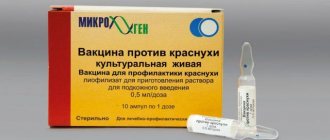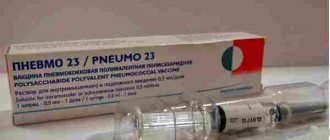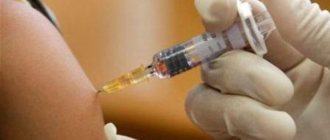Vaccine “against rubella” - Cultured live attenuated rubella vaccine Registration number: LS-002230 Trade name: Cultured live attenuated rubella vaccine International nonproprietary or chemical name: Vaccine for the prevention of rubella Dosage form: Lyophilisate for the preparation of a solution for subcutaneous administration Country of origin : NPO Microgen, Russia Preliminary examination: For persons over 14 years of age, a blood test for anti-Rubella IgG is recommended. Cost of the vaccine: 800 rubles (examination before vaccination is additionally paid) Applicable: For adults and children Dispensing conditions from pharmacies: only for medical, preventive and sanitary institutions
Leave a request for vaccination. Our manager will coordinate an appointment time convenient for you.
Sign up for vaccination
Sign up by phone
+7 (495) 788-000-2
DESCRIPTION OF THE MEDICINE
Cultured live attenuated rubella vaccine, lyophilisate for the preparation of solution for subcutaneous administration, made from “Live attenuated rubella vaccine, substance - frozen solution” (strain RA 27/3) produced by the Institute of Immunology, Inc., Republic of Croatia, (“INSTITUT OF IMMUNOLOGY, INC", CROATIA), registered in the Russian Federation.
Appearance: A homogeneous porous mass of white or light yellow color, a pinkish tint is allowed, hygroscopic. Pharmacotherapeutic group: MIBP vaccine ATX code: J07BJ01
COMPOUND
One vaccination dose (0.5 ml) contains:
Active substance:
- Rubella virus - at least 1000 TCD50 (tissue cytopathic doses).
Excipients:
- Sorbitol - 12.5 mg;
- Gelatin - 6.25 mg;
- L-arginine hydrochloride - 4 mg;
- Maltose - 2.5 mg;
- Sodium chloride - 1.4 mg;
- Lactalbumin hydrolyzate - 1.12 mg
- L-alanine - 0.5 mg;
- Neomycin sulfate - no more than 25 mcg.
INDICATIONS FOR USE
Prevention of rubella in accordance with the National Preventive Vaccination Calendar, vaccination is carried out at the age of 12 months, revaccination at 6 years.
The national calendar of preventive vaccinations also provides for vaccination of children aged 1 to 18 years, who have not been sick, not vaccinated or vaccinated once against rubella, as well as girls aged 18 to 25 years, who have not been sick and have not been vaccinated before
Vaccinations can also be administered to other groups of the population to prevent outbreaks of rubella in limited populations or for epidemiological indications
Purpose
Prevention of rubella.
Routine vaccinations are carried out twice at the age of 12 months and 6 years.
Single vaccination of girls aged 13 years who have not been previously vaccinated and have not had rubella, or girls who have received only one vaccination.
Vaccination against rubella of persons who have not been sick and not previously vaccinated is carried out in accordance with the National Calendar of Preventive Vaccinations of the Russian Federation: children from 5 to 17 years old, girls from 18 to 25 years old.
Vaccinations may also be given to other groups of the population.
CONTRAINDICATIONS
- Immunodeficiency conditions; malignant blood diseases and neoplasms. When prescribing immunosuppressants and radiation therapy, vaccination is carried out no earlier than 12 months after the end of treatment;
- Pregnancy;
- Severe reaction (temperature rise above 40 °C, swelling, hyperemia more than 8 cm in diameter at the site of vaccine administration) or a complication to the previous dose;
- Acute infectious and non-infectious diseases, exacerbation of chronic diseases - vaccination should be carried out no earlier than 1 month after recovery.
Note: HIV infection is not a contraindication to vaccination.
METHOD OF APPLICATION AND DOSAGE
Overdose symptoms have not been established.
Immediately before use, the vaccine is diluted with a solvent (water for injection) at the rate of 0.5 ml of solvent per one vaccination dose of the vaccine. To avoid foaming, the vaccine is dissolved by gently shaking the ampoule. The vaccine should completely dissolve within 3 minutes. The dissolved vaccine is a clear liquid from light yellow to pink. The vaccine and solvent in ampoules with damaged integrity, labeling, or changes in their physical properties (color, transparency, etc.) or improperly stored are not suitable for use.
The opening of ampoules and the vaccination procedure are carried out in strict compliance with the rules of asepsis and antiseptics. The ampoules at the incision site are treated with 70° alcohol and broken off, while preventing alcohol from entering the ampoule. To dilute the vaccine, suck out the entire required volume of solvent and transfer it to an ampoule with dry vaccine. After mixing, the vaccine is drawn into a sterile syringe with another needle and used for vaccination.
The vaccine is administered subcutaneously in a dose of 0.5 ml. in the shoulder area after pre-treating the skin at the site of vaccine administration with 70° alcohol.
The dissolved vaccine is used immediately and cannot be stored.
The vaccination performed is registered in the established registration forms, indicating the name of the drug, date of vaccination, dose, manufacturer, batch number, expiration date, reaction to the vaccination.
Rubella vaccine
Cultural live attenuated rubella vaccine, lyophilisate for preparing a solution for subcutaneous administration, made from “Live attenuated rubella vaccine, substance – frozen solution.” Purpose
Prevention of rubella. Routine vaccinations are carried out twice at the age of 12 months and 6 years. A single vaccination for girls aged 13 years who have not previously been vaccinated and have not had rubella, or girls who have received only one vaccination. Vaccination against rubella of persons who have not been sick and not previously vaccinated is carried out in accordance with the National Calendar of Preventive Vaccinations of the Russian Federation: children from 5 to 17 years old, girls from 18 to 25 years old. Vaccinations may also be given to other groups of the population.
Contraindications
- immunodeficiency states; malignant blood diseases and neoplasms. When prescribing immunosuppressants and radiation therapy, vaccination is carried out no earlier than 12 months after the end of treatment;
- pregnancy;
- severe reaction (temperature rise above 40°C, swelling, hyperemia more than 8 cm in diameter at the site of vaccine administration) or a complication to the previous dose;
- acute infectious and non-infectious diseases, exacerbation of chronic diseases - vaccination should be carried out no earlier than 1 month after recovery.
Note: HIV infection is not a contraindication to vaccination.
Warnings
The vaccine should not be administered during pregnancy. Precautions must be taken to avoid conception for 2 months after vaccination.
Interaction with other drugs
Vaccination against rubella can be carried out simultaneously (on the same day) with other calendar vaccinations (against whooping cough, diphtheria, tetanus, mumps, measles, polio, hepatitis B) or no earlier than 1 month after the previous vaccination. When simultaneous vaccination, drugs are administered to different places; mixing vaccines in one syringe is prohibited.
Immunoglobulins and blood products:
After administration of blood products (immunoglobulin, plasma, etc.), the vaccine is recommended to be administered no earlier than 3 months later. After administration of the rubella vaccine, blood products can be administered no earlier than 2 weeks later; If it is necessary to use immunoglobulin earlier than this period, vaccination against rubella should be repeated after 3 months. If there are antibodies to the rubella virus in the blood serum, repeated vaccination is not carried out.
Directions for use and dosage
Immediately before use, the vaccine is diluted with a solvent (water for injection) at the rate of 0.5 ml of solvent per one vaccination dose of the vaccine. To avoid foaming, the vaccine is dissolved by gently shaking the ampoule. The vaccine should completely dissolve within 3 minutes. The dissolved vaccine is a clear liquid from light yellow to pink. The vaccine and solvent in ampoules with damaged integrity, labeling, or changes in their physical properties (color, transparency, etc.) or improperly stored are not suitable for use.
The opening of ampoules and the vaccination procedure are carried out in strict compliance with the rules of asepsis and antiseptics. The ampoules at the incision site are treated with 70° alcohol and broken off, while preventing alcohol from getting into the ampoule. To dilute the vaccine, suck out the entire required volume of solvent and transfer it to an ampoule with dry vaccine. After mixing, the vaccine is drawn into a sterile syringe with another needle and used for vaccination.
The vaccine is administered subcutaneously in a dose of 0.5 ml into the shoulder area after pre-treating the skin at the site of vaccine administration with 70° alcohol.
The dissolved vaccine is used immediately and cannot be stored.
The vaccination performed is registered in the established registration forms, indicating the name of the drug, date of vaccination, dose, manufacturer, batch number, expiration date, reaction to the vaccination.
Side effects
At the injection site, short-term hyperemia, swelling and induration may develop, accompanied by pain. The vaccine may cause the following adverse reactions of varying severity in some vaccinated individuals:
- rash;
- short-term increase in temperature to subfebrile levels; higher temperature in some vaccinated people;
- cough, runny nose, malaise, headache;
- nausea;
- lymphadenopathy (enlargement of predominantly occipital and posterior cervical lymph nodes).
Those vaccinated in post-pubertal age may experience arthralgia or arthritis, and in rare cases, polyneuritis.
All these reactions are characterized by a short-term course and go away without treatment.
SIDE EFFECTS
- At the injection site, short-term hyperemia, swelling and induration may sometimes develop, accompanied by pain;
- Skin rash (in the form of small roseola or purple spots of varying sizes);
- A short-term increase in temperature to subfebrile levels; higher temperature in some vaccinated people;
- Lymphadenopathy (enlargement of predominantly occipital and posterior cervical lymph nodes);
- Cough, runny nose, malaise, headache;
- Nausea;
- Arthralgia (in the knee and wrist joints); these reactions occur between 10 and 15 days. after immunization;
- Transient arthritis with and without effusion into the joint cavity;
- Transient polyneuropathy;
- Thrombocytopenic purpura.
All these reactions are characterized by a short-term course and go away without treatment.
Considering the possibility of developing immediate allergic reactions (anaphylactic shock, Quincke's edema, urticaria) in particularly sensitive individuals, vaccinated persons must be provided with medical supervision for 30 minutes. Vaccination sites must be provided with anti-shock therapy.
Possible side effects
Infrequently, during the first 24 hours, short-term hyperemia, swelling and induration may develop at the injection site, accompanied by pain. Rarely , some vaccinated people may develop a short-term increase in temperature to subfebrile levels on days 6-14, accompanied by catarrhal symptoms; mild skin rash, lymphadenopathy (enlargement of predominantly occipital and posterior cervical lymph nodes). These reactions are characterized by a short-term course and pass without treatment. Very rarely, 1-3 weeks after immunization, thrombocytopenic purpura and immediate allergic reactions, including anaphylactic reactions, arthralgia, and arthritis occur.
Their frequency in teenage girls does not exceed 5%; in adult women it can reach up to 25%. This form of complications is very rare in young children and men vaccinated against rubella. Considering the possibility of developing immediate allergic reactions (anaphylactic shock, Quincke's edema, urticaria) in particularly sensitive individuals, vaccinated persons must be provided with medical supervision for 30 minutes. Come get vaccinated at ONNI.
A full range of vaccines for children and adults, family vaccinations - at a special price! Call a doctor at home Make an appointment with a doctor or call +7 (812) 331-17-74
INTERACTIONS WITH OTHER MEDICINES
Vaccination against rubella can be carried out simultaneously (on the same day) with other calendar vaccinations (against whooping cough, diphtheria, tetanus, mumps, measles, polio, hepatitis B) or no earlier than 1 month after the previous vaccination. When simultaneous vaccination, drugs are administered to different places; mixing vaccines in one syringe is prohibited.
Immunoglobulins and blood products:
After administration of blood products (immunoglobulin, plasma, etc.), the vaccine is recommended to be administered no earlier than 3 months later. After administration of the rubella vaccine, blood products can be administered no earlier than 2 weeks later; If it is necessary to use immunoglobulin earlier than this period, vaccination against rubella should be repeated after 3 months. If there are antibodies to the rubella virus in the blood serum, repeated vaccination is not carried out.
Use during pregnancy and breastfeeding. The vaccine should not be administered during pregnancy. Precautions must be taken to avoid conception for 2 months after vaccination. Accidental vaccination of a pregnant woman is not an indication for termination of pregnancy.
M-M-R II Vaccine against measles, mumps and rubella, live lyof. 1 dose vial in a set with a solution for subcutaneous application
Method of administration and dosage FOR SUBSCUTANEOUS ADMINISTRATION. THE VACCINE CANNOT BE ADMINISTERED INTRAVENOUSLY. Human immunoglobulin should not be administered simultaneously with the vaccine (see section “interaction with other drugs”),
The vaccine is administered subcutaneously, preferably into the outer surface of the upper third of the shoulder. The vaccine dose is the same for all ages and is 0.5 ml.
Cautions:
For each injection and/or dissolution of the vaccine, you should use a sterile syringe that does not contain preservatives, antiseptics and detergents, because these substances can inactivate the live vaccine virus.
To dissolve the vaccine, use only the sterile solvent supplied with the vaccine (water for injection), because it does not contain preservatives or other antiviral substances that could inactivate the vaccine.
Each bottle of reconstituted solution of the M-M-P II ® vaccine must be visually inspected for the absence of mechanical particles and color changes before injection. The reconstituted solution of M-M-P II ® vaccine should be clear and yellow in color.
Recommended vaccination schedule:
Children first vaccinated at 12 months of age and older should be revaccinated according to the national vaccination schedule at 6 years of age.
Other aspects of vaccination:
Women of childbearing age.
Immunization of non-pregnant, non-immune girls and women of childbearing age with a live attenuated vaccine against rubella, measles and mumps is indicated subject to certain precautions (see section “use during pregnancy and 13 breastfeeding period”). Vaccination of non-immune women of childbearing age protects them from rubella during pregnancy, which in turn prevents the fetus from becoming infected and developing congenital rubella lesions.
Women of childbearing age are advised to protect themselves from pregnancy for 3 months after vaccination. They should be informed of the reasons for such precautions (see section “Use during pregnancy and breastfeeding”).
Conducting serological studies of women of childbearing age to determine their susceptibility to rubella, followed by vaccination of seronegative individuals, is desirable, but not mandatory.
Women of childbearing age should be informed of the high likelihood of developing usually transient arthralgia or arthritis 2-4 weeks after vaccination (see section "Side Effects").
Women in the postpartum period:
In many cases, vaccination of women susceptible to rubella immediately after childbirth is justified (see section “use during pregnancy and breastfeeding”).
Other settlement groups:
Unvaccinated and rubella-naïve children over 12 months of age who are in contact with a susceptible pregnant woman should be vaccinated against rubella (monovalent rubella vaccine or M-M-P II ® vaccine) to reduce the risk of possible infection in the pregnant woman.
Vaccination is also recommended for susceptible individuals from high-risk groups, such as students, health care workers, and military personnel.
Non-immune persons may become infected with measles, mumps and rubella viruses during their stay abroad and bring them to their country of permanent residence. Before travel, persons susceptible to one or more of these diseases can be given either the monovalent vaccine or the M-M-P II* vaccine. Persons susceptible to mumps and rubella viruses are recommended to receive the M-M-P II vaccine; persons susceptible to the measles virus in the absence of a monovalent measles vaccine are recommended to receive the M-M-P II vaccine, regardless of their immune status regarding mumps and rubella viruses.
According to exposure protective vaccination:
Vaccination of contacts of a person with measles may provide some protection if the vaccine is administered within 72 hours of exposure. If the vaccine was administered several days before infection, then in this case a high preventive effect will be achieved. There are no definitive data on the effectiveness of vaccination of contacts of a patient with mumps and rubella.
Use with other vaccines:
The M-M-P II® vaccine should be administered 1 month before or 1 month after the administration of other live viral vaccines.
M-M-P II® vaccine was administered concomitantly with Haemophilus influenza type b conjugate inactivated vaccine and live attenuated varicella vaccine, with the vaccines administered using different syringes at different sites on the body. No disturbances in the immune response to the administered antigens were found, and the nature, frequency and severity of adverse reactions were similar to those when the vaccines were administered separately. The use of DTP (diphtheria-tetanus-pertussis vaccine) and/or OPV (oral polio vaccine) concomitantly with the measles, mumps, and rubella vaccine is not recommended due to limited data on the results of their simultaneous administration.
Other immunization regimens were also used. Data from published studies regarding coadministration of recommended vaccines for routine immunization (eg, DTP [or DTaP], IPV [or OPV], Haemophilus influenzae type b vaccine with or without hepatitis B vaccine, and varicella vaccine) with other pediatric vaccines (live, attenuated or inactivated) have not shown any interaction between them.
Recommendations for preparing and conducting vaccination:
Fill the syringe completely with solvent. Add all the solvent to the vial of lyophilized vaccine and mix thoroughly. Draw the entire contents of the vial into a syringe and inject completely subcutaneously. It is recommended to use the vaccine as soon as possible after dissolution.
To prevent transmission of hepatitis B virus and other infectious agents, disposable, sterile syringes and needles should be used.







